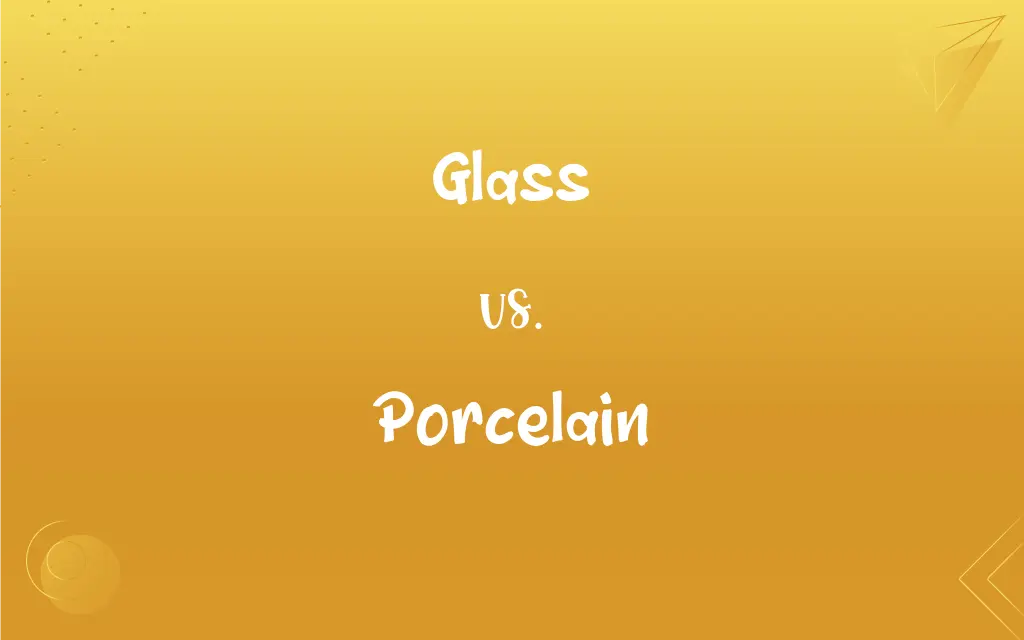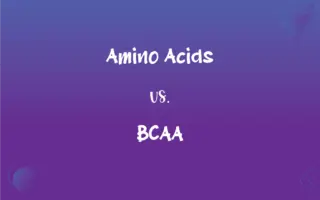Glass vs. Porcelain: What's the Difference?
By Janet White || Updated on November 13, 2023
Glass is a transparent or translucent material made from sand and other minerals. Porcelain is a white, translucent ceramic made from kaolin and fired at high temperatures.

Key Differences
Glass is typically made by melting sand (silica), soda ash, and lime at high temperatures, resulting in a clear, amorphous solid. Porcelain, on the other hand, is made from kaolin clay mixed with other minerals, fired at temperatures over 1200°C to achieve its hardness and translucent quality.
Glass is known for its transparency and versatility. It is used in windows, bottles, and art due to its ability to be molded into various shapes and colored or decorated in many ways. Porcelain is valued for its strength, durability, and impermeability, making it ideal for dinnerware, tiles, and decorative objects. It is less transparent than glass and often features intricate designs.
Glass has a unique aesthetic, often associated with modernity and cleanliness. It plays a significant role in architecture and interior design. Porcelain is often associated with elegance and refinement. It has a rich history, especially in East Asian and European cultures, and is commonly used in fine dining and high-end decor.
Glass is hard yet brittle, and can shatter under impact. It is a good insulator of heat and electricity. Porcelain is also hard but more dense and less likely to shatter compared to glass. It is known for its resistance to thermal shock and chemical attack.
Glass is recyclable and can be repurposed multiple times without losing purity or quality. Porcelain, though durable and long-lasting, is not as easily recyclable as glass. However, its longevity can make it a sustainable option if used over a long period.
ADVERTISEMENT
Comparison Chart
Composition
Made from sand, soda ash, and lime
Made from kaolin clay and other minerals
Temperature Resistance
Generally less heat resistant
Higher heat resistance
Transparency
Transparent or translucent
Opaque with a glossy finish
Durability
Brittle and prone to shattering
Hard, dense, and more chip-resistant
Cultural Significance
Modernity, versatility in design
Elegance, historical value in art
ADVERTISEMENT
Glass and Porcelain Definitions
Glass
A hard, brittle substance made by melting sand with soda ash and lime.
The glass window shattered into a thousand pieces.
Porcelain
Tableware made from porcelain material.
They set the table with elegant porcelain dishes.
Glass
A drinking vessel made from glass material.
She poured the water into a tall glass.
Porcelain
A white, translucent ceramic made from fine clay.
The porcelain vase was a family heirloom.
Glass
A lens or optical instrument made of glass.
He adjusted the glasses on his nose to see better.
Porcelain
Dental fixtures made of porcelain, such as crowns or veneers.
He got a porcelain crown to restore his damaged tooth.
Glass
To encase or cover with glass.
The artist glassed the painting to protect it.
Porcelain
A doll made with a porcelain head and limbs.
The porcelain doll sat delicately on the shelf.
Glass
A reflective surface made from coated glass.
She looked at her reflection in the glass.
Porcelain
Ceramic tiles made from porcelain, used in flooring and walls.
The kitchen floor was laid with glossy porcelain tiles.
Glass
Any of a large class of materials with highly variable mechanical and optical properties that solidify from the molten state without crystallization, are typically made by silicates fusing with boric oxide, aluminum oxide, or phosphorus pentoxide, are generally hard, brittle, and transparent or translucent, and are considered to be supercooled liquids rather than true solids.
Porcelain
A hard, white, translucent ceramic made by firing a pure clay and then glazing it with variously colored fusible materials; china.
Glass
A drinking vessel.
Porcelain
An object made of this substance.
Glass
A mirror.
Porcelain
A hard white translucent ceramic, originally made by firing kaolin, quartz, and feldspar at high temperatures but now also inclusive of similar artificial materials; also often (figurative) such a material as a symbol of the fragility, elegance, etc. traditionally associated with porcelain goods.
Tableware and toilets are both made of porcelain.
FAQs
Is glass a natural material?
Glass is a man-made material, although its primary ingredient, silica, is natural.
Are all glass products shatterproof?
No, standard glass is brittle and can shatter, but special treatments can make it more resistant.
What is the primary component of glass?
Glass is primarily made from silica, obtained from sand.
Can glass be recycled?
Yes, glass is highly recyclable and can be reused multiple times.
Are there different types of glass?
Yes, there are various types, including tempered, laminated, and stained glass.
Is porcelain only used for making dishes?
No, porcelain is also used for tiles, dolls, and dental fixtures.
How is porcelain different from other ceramics?
Porcelain is fired at higher temperatures, making it denser and more durable.
Is porcelain recyclable?
Porcelain is not as easily recyclable as glass, but its durability lends to sustainability.
Why is glass transparent?
Glass is transparent due to its amorphous structure, allowing light to pass through.
What defines porcelain?
Porcelain is a type of ceramic known for its strength, whiteness, and translucency.
What makes porcelain valuable in art?
Porcelain's fine texture and ability to hold detailed designs make it valuable in art.
Can glass be repaired if broken?
While some glass items can be repaired, many shatter beyond repair.
Is glass used in technology?
Glass is used in technology, notably in screens and fiber optics.
What is the history of porcelain in China?
China has a rich history of porcelain making, dating back to the Tang dynasty.
Can porcelain be colored?
Yes, porcelain can be colored and often features intricate designs.
How is glass colored?
Glass is colored by adding metallic salts during its production.
Can porcelain withstand high temperatures?
Yes, porcelain is known for its high thermal resistance.
Why is glass used in windows?
Glass is used for its transparency and ability to let light pass through.
What is the environmental impact of glass production?
Glass production can be energy-intensive but is offset by its recyclability.
How is porcelain made?
Porcelain is made from kaolin clay, fired at high temperatures.
About Author
Written by
Janet WhiteJanet White has been an esteemed writer and blogger for Difference Wiki. Holding a Master's degree in Science and Medical Journalism from the prestigious Boston University, she has consistently demonstrated her expertise and passion for her field. When she's not immersed in her work, Janet relishes her time exercising, delving into a good book, and cherishing moments with friends and family.
































































